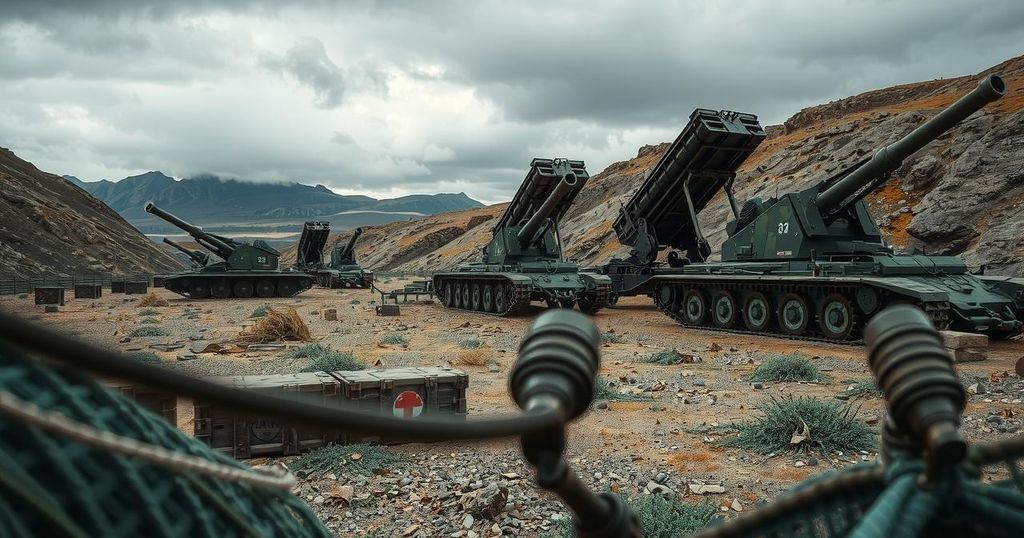World news
ASIA, DEFENCE, EUROPE, EUROPE/ASIA, FORBES, KOKSAN, KOREA, NORTH, KOREA, SOUTH, KURSK, KURSK OBLAST, KYIV, MILITARY, MILITARY CLASHES, MISSILE ATTACK, MOSCOW, PYONGYANG, RUBICON CENTER OF ADVANCED UNMANNED SYSTEMS, RUSSIA, RUSSIAN ATTACKS, SEOUL, SOUTH KOREA, SUDZHA, UKRAINE, UKRAINIAN 14TH REGIMENT OF UNMANNED AERIAL SYSTEMS, US, WAR
Jamal Robinson
0 Comments
Ukrainian HIMARS Strike Allegedly Damages North Korean Howitzers in Kursk
The Ukrainian 14th Regiment reportedly damaged three North Korean M1989 howitzers in a strike coordinated via drone operators. Utilizing HIMARS artillery, the Ukrainian battery targeted the howitzers concealed in trees in Kursk Oblast. Collectively, both the Russians and North Koreans suffered significant casualties during their engagement with Ukrainian forces, who maintain ongoing operational capabilities despite challenges.
Forbes reports that the Ukrainian 14th Regiment of Unmanned Aerial Systems allegedly damaged three North Korean M1989 howitzers in a coordinated strike. This incident occurred around March 18, when drone operators identified the 170-millimeter artillery hidden in treetops in Kursk Oblast, Russia, and relayed their coordinates to a nearby battery equipped with High-Mobility Artillery Rocket Systems (HIMARS).
Armed with approximately 40 HIMARS units from the United States, the Ukrainian battery fired at least one M30 rocket, which detonated above the treetops, dispersing hundreds of grenade-sized submunitions on the targeted howitzers and their crews. Assessing the full extent of the damage remains challenging.
The M1989 Koksan, a North Korean self-propelled artillery system first displayed in a 1989 parade, weighs 40 tons and features a unique 170-mm caliber allowing for considerable range; conventional shells can extend up to 40 kilometers, and reactive rounds may reach up to 60 kilometers. Forbes indicates that North Korea has supplied Moscow with a substantial number of weaponry, including M1989s, anti-tank missile vehicles, rocket launchers, and air defense systems.
Prior to the recent strike, Ukrainian forces had already destroyed at least one M1989 and several Bulsae-4 anti-tank launchers, alongside a Russian drone operator accidentally eliminating a North Korean air defense system due to a targeting error. A large Ukrainian contingent had maintained a salient in Kursk, until it was significantly compromised by an assault on their supply line by the Rubicon Center of Advanced Unmanned Systems.
Simultaneously, a subsequent North Korean troop advance occurred in Kursk, which further constrained the Ukrainian position. Consequently, the remaining Ukrainian forces retreated, abandoning vital equipment. Nonetheless, Ukrainian drones and artillery persisted in their strikes against Russian and North Korean units in the region.
Forbes characterizes the Kursk conflict as a Pyrrhic victory for Russian and North Korean forces, suggesting they incurred heavy casualties, potentially tens of thousands, along with hundreds of vehicle losses while pressuring Ukrainian forces to withdraw. While Ukrainian losses were significant, they were relatively less severe in comparison.
In conclusion, the report from Forbes highlights a notable incident involving the Ukrainian 14th Regiment of Unmanned Aerial Systems damaging North Korean M1989 howitzers amidst ongoing conflicts in Kursk Oblast. The attack illustrates the continued tactical shifts in the region, as both sides adapt to the evolving battlefield dynamics. Despite facing setbacks, Ukrainian forces remain resilient in their efforts against their adversaries, underscoring the complexities and human costs of the conflict.
Original Source: euromaidanpress.com




Post Comment